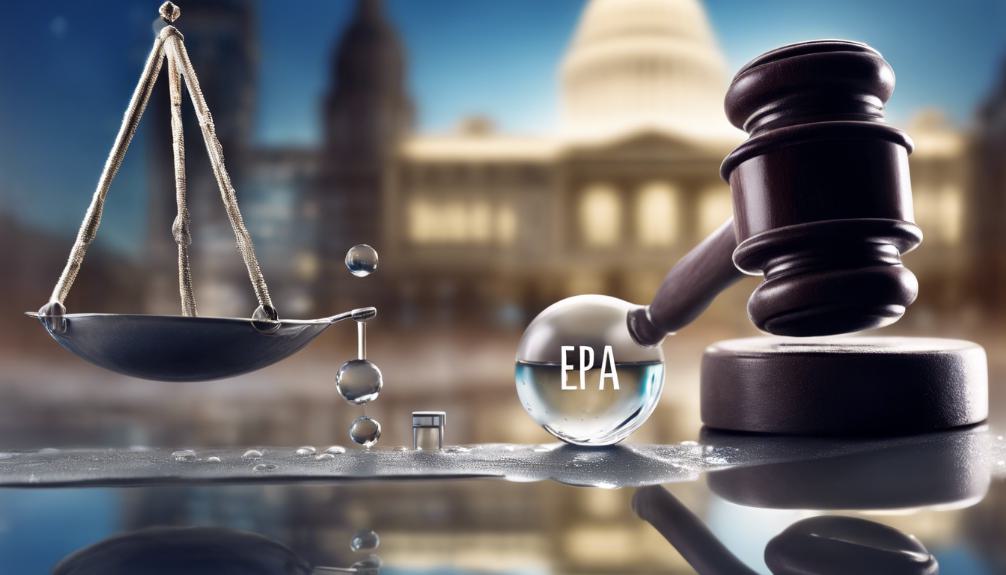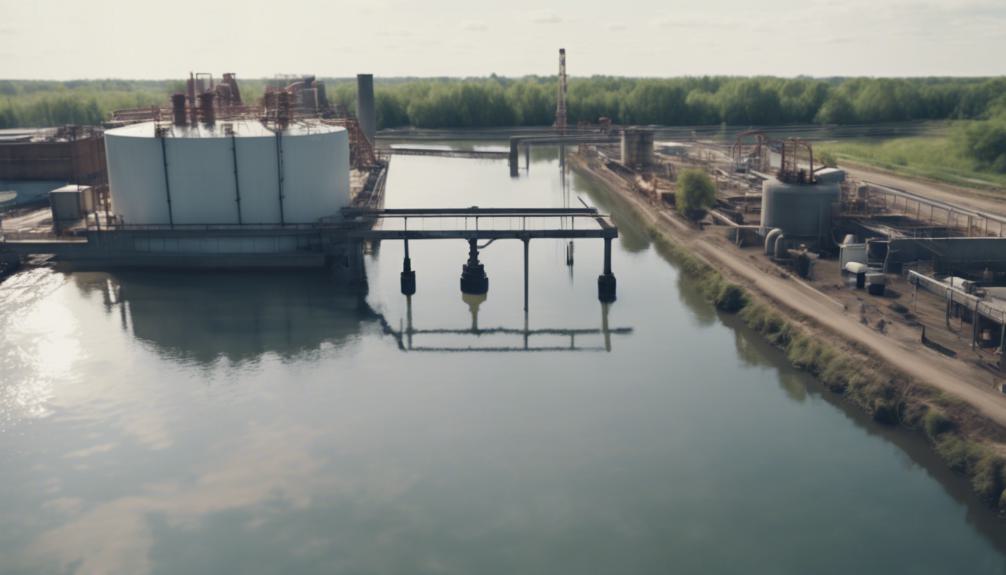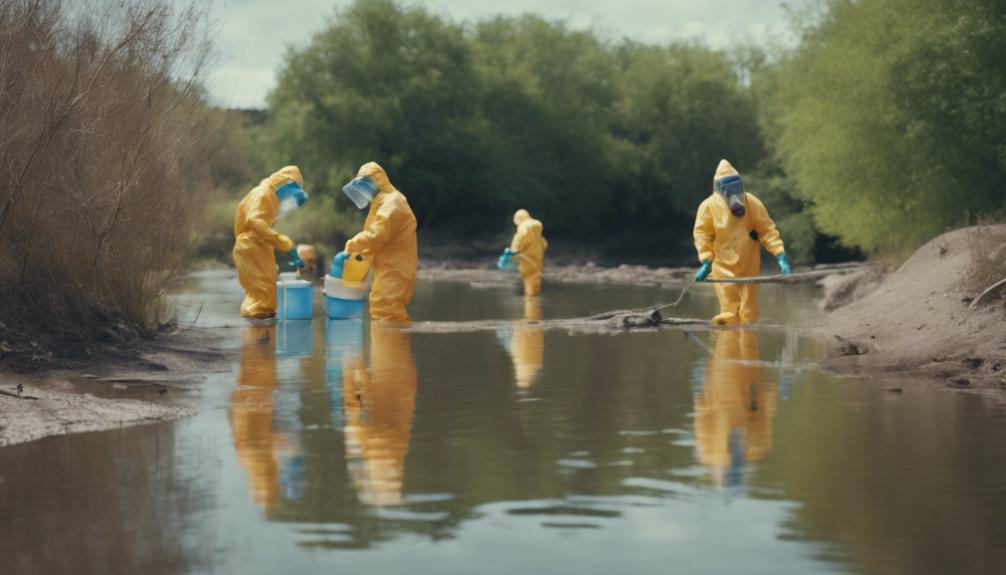PFAS News March 2024
While some might argue that the battle against PFAS contamination is advancing too slowly, March 2024 has brought us closer to significant breakthroughs in regulation and detection. In our latest coverage, we've seen the EPA step up with tougher regulations and innovative testing methods, highlighting an intensified commitment to tackling PFAS pollution. But what does this mean for communities previously affected and industries held accountable under these new rules? Join us as we explore the ripple effects of these updates, uncovering the broader implications for environmental safety and public health that lie just beneath the surface.

Key Takeaways
- EPA proposes stricter regulations and science-based limits for 6 PFAS in drinking water.
- Advanced technologies like activated carbon and ion exchange systems are crucial for PFAS removal.
- Community health initiatives emphasize the importance of local engagement and education on PFAS risks.
- Ongoing research and collaboration are key to developing effective PFAS cleanup and remediation strategies.
EPA Regulatory Updates

In recent updates, the EPA's taken significant steps to regulate PFAS by proposing and finalizing rules that target these persistent pollutants. We've seen a proactive approach from the agency, especially with its proposal to add nine PFAS to the list of hazardous constituents under the Resource Conservation and Recovery Act (RCRA) rules in February 2024. This move signifies a substantial advance in how these chemicals are managed and disposed of, ensuring they're treated with the caution they warrant due to their hazardous nature.
In addition, the Significant New Use Rule finalized in January 2024, which restricts the use of 329 inactive PFAS without EPA oversight, shows the agency's commitment to not just managing existing threats but also preemptively addressing potential future risks. This rule highlights the EPA's vigilance in monitoring and controlling the introduction of these substances into our environment.
The proposed designation of PFOA and PFOS as hazardous substances under the Comprehensive Environmental Response, Compensation, and Liability Act (CERCLA) in August 2022 further underscores the EPA's dedication to tackling PFAS pollution. By considering these substances hazardous, the EPA aims to enhance the cleanup of contaminated sites, ensuring a healthier environment for us all.
Groundbreaking Research Insights

Building on the regulatory strides made by the EPA, we're now focusing on recent research that highlights the significant health and environmental risks posed by PFAS exposure. This fresh wave of studies has peeled back layers on how PFAS, notorious for their persistence, wreak havoc on human health and ecosystems. It's alarming to learn about their direct link to cancer, immune suppression, and developmental issues.
Our community's been particularly attentive to the innovative strides in detecting, monitoring, and remediating PFAS contamination across various environmental settings. The capability to trace PFAS more essential is vital for our fight against these pollutants.
Additionally, the insights gained into the persistence and bioaccumulation characteristics of PFAS are eye-opening. They underline the profound, long-lasting impacts these chemicals have on our environment.
As we digest these latest findings, it's clear the urgency to act is more pronounced than ever. Implementing strict regulations and effective management practices isn't just recommended; it's imperative. These research revelations are pivotal in guiding our next steps in tackling the PFAS contamination crisis. Together, we're committed to safeguarding our health and the environment from these insidious chemicals.
Drinking Water Safeguards

As we move forward, it's essential we focus on the latest in PFAS removal technologies and the recent updates to regulatory standards. These steps are critical for addressing the widespread presence of PFAS in our drinking water and the associated health risks. Together, we're committed to safeguarding public health by ensuring our water is clean and safe.
PFAS Removal Technologies
We're exploring various PFAS removal technologies to guarantee our drinking water remains safe and clean. Among these, activated carbon filtration stands out for its ability to adsorb PFAS compounds, effectively purifying water. Similarly, ion exchange systems offer a targeted approach by replacing PFAS ions with harmless ones in the resin, showcasing another layer of drinking water safeguards. Meanwhile, membrane filtration, particularly reverse osmosis, leverages size exclusion properties to block PFAS molecules from passing through, ensuring a high level of purification. As research progresses, we're committed to enhancing these technologies, constantly improving our defenses against PFAS and ensuring that our communities have access to clean, safe drinking water.
Regulatory Standards Update
While exploring various PFAS removal technologies guarantees safer drinking water, it's equally important to examine the latest updates in regulatory standards aiming to protect public health. The EPA proposed science-based limits for 6 PFAS in drinking water, a significant step toward safeguarding our communities. With 40 states currently aligning with a national drinking water standard, the urgency for a unified regulatory approach is undeniable. The revelation that over 200 million Americans might have PFOA or PFOS in their drinking water underscores the critical need for immediate congressional action to address this contamination crisis. We're committed to closely monitoring these developments, as continued efforts to release more PFAS data by 2025 will undeniably enhance regulatory standards, ensuring the health and safety of our public.
Community Health Initiatives

We're turning our attention to the critical role of community health initiatives in battling PFAS contamination. Local PFAS screening programs and health impact awareness campaigns are at the forefront of these efforts, aiming to protect residents and inform them about the risks. It's about making sure everyone's on the same page and equipped with the knowledge to safeguard their health.
Local PFAS Screening Programs
Local PFAS screening programs are pivotal in testing residents' water sources for contamination, ensuring community health and safety. We're committed to identifying PFAS levels in well water through these community health initiatives, offering free testing to all residents. By signing up, individuals can safeguard their water, addressing potential health risks head-on. The results from these screening programs are vital; they'll reveal the extent of PFAS contamination in our area. It's a collaborative effort, with agencies and community organizations joining forces to tackle PFAS exposure. Through these screenings, we're not just testing water; we're protecting our community's health, ensuring everyone has access to safe, clean water. It's a step forward in our fight against PFAS contamination.
Health Impact Awareness Campaigns
Building on our commitment to safeguard community health, our next focus is launching Health Impact Awareness Campaigns to educate about the dangers of PFAS exposure. Through these community health initiatives, we're raising awareness about the health impacts of PFAS and educating residents on the risks PFAS contamination poses to public health. Our programs are designed to inform communities about the potential health issues associated with PFAS exposure. We aim to empower individuals to take proactive steps to protect their health from PFAS. It's essential that everyone is well-informed and equipped to address PFAS-related health concerns. Together, we're working to guarantee our community's safety and well-being amidst the challenges posed by PFAS contamination.
Industrial Compliance Measures

Numerous industries are now taking decisive steps to align with EPA and state-level regulatory requirements concerning PFAS, implementing risk assessments and remediation strategies to mitigate contamination risks. By focusing on industrial compliance measures, companies are not just adhering to existing laws but are also preparing for the future. This proactive approach involves conducting thorough risk assessments to pinpoint potential sources of PFAS contamination within their operations. Once identified, the development and implementation of targeted remediation solutions become a priority to manage and, ideally, eliminate these risks.
As regulations around PFAS continue to evolve, staying ahead of the curve is essential for businesses looking to ensure compliance and minimize their environmental footprint. This commitment to evolving regulations demands a robust framework for monitoring and reporting, helping companies track their progress and make necessary adjustments to their strategies. However, we're finding that the path to compliance is filled with challenges, including the need for effective remediation efforts that meet the stringent standards set forth by regulatory bodies.
Through it all, we're committed to sailing through these challenges, adopting thorough industrial compliance measures that not only aim to protect the environment but also safeguard our communities from the potential impacts of PFAS contamination.
Cleanup and Remediation Actions

We're taking decisive steps towards cleanup and remediation actions to tackle PFAS contamination, starting with thorough well-testing initiatives in the West Plains area. Recognizing the urgency of the issue, we've partnered with the Environmental Protection Agency (EPA) and the Washington State Department of Ecology to roll out a thorough well-testing program. This initiative has already seen 144 property owners in the area signing up for free testing, a critical first step in evaluating the scale of contamination.
Over the next two weeks, these wells will undergo sampling, with results expected to be shared with homeowners about a month after. This process is not only about identifying the presence of PFAS but also about understanding its concentration levels. Residents concerned about their water quality can still sign up for testing at the designated website, ensuring nobody is left unaware of the safety of their water.
For those whose well tests reveal PFAS levels above state recommendations, we're providing immediate solutions. This includes offering free bottled water and installing filters at no cost to the residents, ensuring their access to clean, safe water. Our collaboration with the West Plains Water Coalition amplifies these efforts, ensuring that together, we're not just addressing, but actively working to clean up PFAS contamination in our communities.
Future PFAS Challenges

Having outlined our current cleanup and remediation efforts, it's imperative we now focus on the future challenges PFAS contamination presents. As we look ahead, the need for ongoing regulatory actions becomes clear. Addressing PFAS contamination across different environmental media will require not only steadfast commitment but also innovative approaches.
Developing and implementing effective remediation solutions for PFAS-affected sites is critical to make sure we're not merely moving the problem but genuinely solving it. Additionally, as PFAS regulation evolves, industries will face significant compliance challenges. Shifting to safer alternatives while maintaining operational efficiency demands a delicate balance and foresight.
The complexity of PFAS regulation and standards may create hurdles, especially in achieving consistency across jurisdictions. This inconsistency can undermine our collective efforts for thorough control and public health protection. Collaboration among stakeholders—government agencies, industries, communities, and scientists—is fundamental. We must work together to tackle these challenges head-on, making sure that our approach to PFAS contamination is both effective and sustainable. Protecting public health and the environment from the impacts of PFAS requires our unified and relentless effort.
Frequently Asked Questions
What Are the PFAS Rules for 2024?
We're curious about the PFAS regulations for 2024. It seems the EPA's ramping up efforts, like adding nine PFAS to hazardous lists and tightening rules on their use to protect our health and environment.
Is PFAS Remains Front Burner Issue Heading Into 2024?
We've noticed PFAS is still a hot topic as 2024 approaches. With ongoing EPA actions and community concerns, it's apparent we need to stay informed and involved in the conversation.
How Do You Flush PFAS Out of Your Body?
We've found that drinking plenty of water, eating a diet rich in fiber, fruits, and vegetables, exercising regularly, and avoiding processed foods can help flush PFAS from our bodies and support natural detoxification processes.
What State Has the Most PFAS Contamination?
We've found out that Michigan has the most PFAS contamination sites in the country, with over 192 locations. It's linked to various sources like industrial sites and military bases, impacting our water greatly.

This post has been generated by AI and was not reviewed by editors. This is Not legal advice. Please consult with an attorney.




